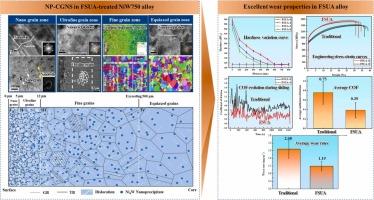通过纳米沉淀和复合梯度纳米结构的结合,NiW750合金具有优异的耐磨性
IF 6.3
2区 材料科学
Q2 CHEMISTRY, PHYSICAL
引用次数: 0
摘要
中重合金,如NiW750合金,预计在极端条件下作为弹头材料应用具有优异的耐磨性。本文提出了锻造→固溶→超声喷丸(USP)→时效(简化为FSUA)的新工艺路线,在NiW750合金中构建纳米沉淀与复合梯度纳米结构(NP-CGNS)相结合的结构,以获得优异的耐磨性。拉伸和硬度测试表明,FSUA处理改善了强度-塑性组合和表面硬度,并产生了最佳的USP处理时间为6分钟(称为FSUA-6),从而获得了最理想的性能。FSUA-6中存在NP-CGNS结构,硬化层深度超过500 μm,由梯度纳米晶粒、梯度纳米孪晶、梯度位错结构共同组成,且Ni4W纳米颗粒数量密度更高。与未经usp处理的FSUA-0相比,FSUA-6的平均COF和磨损率分别降低了48%和42.8%。对磨损表面的表征表明,FSUA-6中分层、剥落和氧化现象减少,磨损碎片细化,表面粗糙度参数Ra和Rmax分别降低了75%和86%。磨损性能的改善主要来自于NP-CGNS的分层强化,其在磨损过程中抵抗塑性变形、裂纹萌生和扩展。本研究为制造高性能耐磨中厚合金提供了新的强化策略和技术途径。本文章由计算机程序翻译,如有差异,请以英文原文为准。

Superior wear resistance in NiW750 alloy through the combined architecture of nanoprecipitation and composite gradient nanostructure
Medium-heavy alloys, such as NiW750 alloy, are expected with superior wear resistance for applying as warhead materials in extreme conditions. In this work, a novel processing route of forging → solid solution → ultrasonic shot peening (USP) → aging (simplified as FSUA) is proposed to construct a combined architecture of nanoprecipitation and composite gradient nanostructure (NP-CGNS) in NiW750 alloy for achieving exceptional wear resistance. Tensile and hardness tests demonstrate an improvement in strength-ductility combination and surface hardness under FSUA treating, and yields the optimal USP treatment duration of 6 min (deemed as FSUA-6) which induces the most desirable properties. NP-CGNS structure is observed in FSUA-6 with a hardened layer depth exceeding 500 μm, co-consisted of gradient nanograin, gradient nanotwin, gradient dislocation structure, and higher number density of finer Ni4W nanoprecipitates. Relative to non-USP treated (deemed as FSUA-0) counterpart, FSUA-6 yields reductions in the average COF and wear rate by 48 % and 42.8 %, respectively. Characterization on worn surfaces reveals reduced delamination, spalling, and oxidation phenomena, and a refinement in wear debris in FSUA-6, along with decreases on surface roughness parameters of Ra and Rmax by 75 % and 86 %, respectively. The improvement in wear behavior is mainly arise from the hierarchical strengthening of NP-CGNS, which resist plastic deformation, crack initiation and propagation during wear. This study provides fresh strengthening strategy and technology pathway for fabricating superior wear-resistant medium heavy alloys.
求助全文
通过发布文献求助,成功后即可免费获取论文全文。
去求助
来源期刊

Journal of Alloys and Compounds
工程技术-材料科学:综合
CiteScore
11.10
自引率
14.50%
发文量
5146
审稿时长
67 days
期刊介绍:
The Journal of Alloys and Compounds is intended to serve as an international medium for the publication of work on solid materials comprising compounds as well as alloys. Its great strength lies in the diversity of discipline which it encompasses, drawing together results from materials science, solid-state chemistry and physics.
 求助内容:
求助内容: 应助结果提醒方式:
应助结果提醒方式:


